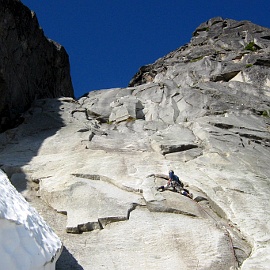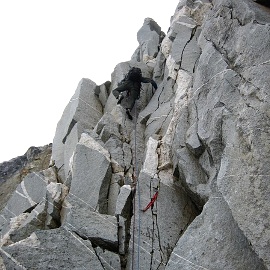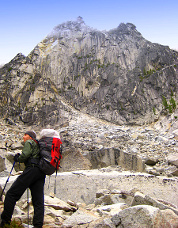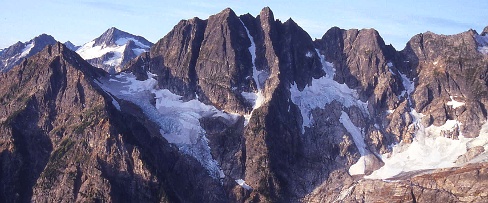|
|
||||||||||||
 |
|||||||||||||
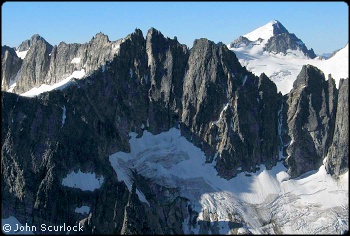 |
|||||||||||||
|
|||||||||||||
|
Inspired by tales of steep, clean granite, and impressed with the attention given to Castle Peak by Fred Beckey and Alan Kearney, I recruited Peter Hirst to join me on a trip to this peak on August 3, 2008. We approached from Canada, but the peak lies just south of the border. Our plan was to make the second ascent of the Colorado Route, a line scoped by Beckey and then climbed by a trio of Colorado climbers who had joined him on the approach. However, detached snow and ice patches above the main glacier kept us left of this route. Instead, we followed cracks and corners up the cleanest granite above the snow patch, fixing one LA piton in the process. We climbed 14 pitches, including some simul-climbing, in a direct line along the left margin of the central buttress. About half the pitches were 5.10, with very clean rock on the bottom half. High on the route, we followed the positive features of a long yellow-colored quartz dike to escape dirtier crack systems. We both found the setting beautiful and the route worthy of repeats. Descent to camp below the glacier was made via the East Ridge, past an obvious col and snow finger. The route took 13 hours. No loose rock was encountered on the climb. IV, 5.10+ -Blake Herrington West Tillie’s Tower, North ArÍte, New Route On August 17, 2008, Rolf Larson and I climbed the North ArÍte of Tillie’s Towers, which are the most prominent northwestern terminus of Austera Ridge. We found solid, mostly clean and featured rock—Eldorado Orthogneiss—offering both nice cracks and gear-protected face climbing. The route featured gobs of 5.8 and 5.7 climbing, with a few moves of 5.9 sprinkled along the way. Joking about a route name, Rolf rightly observed our route was: “an unearthed obscurity destined to return to obscurity.” “Unearthed Obscurity” is also fitting because the adjacent Piltdown Tower refers to Piltdown Man, an archaeological hoax comprised of part man, part monkey—like our team. This route, though certainly not destined for any select guidebook, is a fine place in an out-of-the way, rugged corner of the North Cascades National Park. I dug the cool position and alpine ambiance. During the approach up Thunder Creek it started raining but we decided to go to the route’s base and see what the weather would decide. The first pitch was crack and face climbing on “neat-o” rock. We generally stayed on or within spitting distance of the arÍte crest. On pitch two, I curved right to a chimney system that bypassed an overhanging pillar. Pitch three included a scrappy 5.9 section to a deluxe alcove belay. I drew the nice cracks of pitch four. After the first four steep pitches, the arÍte backs off a bit. The descent starts by rappelling 100ft down the south face, then traversing east and down-climbing steep 4th class to a gully between the Towers. Descend the gully only a little, looking to ascend and traverse east to Austera’s ridge crest, then find your way down and onto to the North Klawatti Glacier, crossing a deep moat. III, 5.9 -Eric Wehrly (The opening photo on this page shows the North Face of the Tillie’s Towers from the air.)
South Early Winter Spire, “Southern Man”, New Route At 8 a.m. on August 24, 2008, Mark Allen, Leighan Falley, and Joel Kauffman started up a striking, continuous, 500-ft dihedral crack to the right of the 1968 Beckey-Leen Direct East Buttress route on South Early Winter Spire. Most of the crack was part of the obscure 1965 Anderson-Myher-Richardson-Young route, which climbs the lower East Buttress to the SE Face of the spire. Allen became intrigued by the route after concluding that the 1965 route was the first climb of any big face at Washington Pass. Atop the third pitch, at the Triangular Ledge, the 2008 party crossed the Beckey-Leen route from right to left. Here they started up a crack system splitting the beautiful upper SE headwall—a continuous dihedral running to the top. Kauffman led the fourth pitch and began finding old iron. The climbing was stellar and the three climbers hung like bats in a crack belay under an alcove roof. Allen reported that the SE face felt like a mini big wall: steep, exposed, and requiring tricks. The 1965 party bivied and retreated from this steep system via a two-pitch pendulum, then finished on easier ground to the left. Kauffman continued his block head-on with steep aid climbing. Allen took over the lead and found the next pitch dirtier than the last. He begin short-fixing the steep dihedral, and the crack yielded to straightforward aiding. Ultimately he stretched out the rope 60m, fixed the line and watched the day’s light fade to gray as the others jugged. After fifty feet of climbing to the crest they topped out in the dark. IV, 5.9+ C1 Colchuck Balanced Rock, “The Tempest”, New Route With a rain and snow storm parked over most of the Cascades, Sol Wertkin and I changed our North Cascades objective and headed to the drier side of the range on August 27, 2008. With visions of splitter Enchantments granite in our minds, we slogged the four miles to Colchuck Lake, eyeing dark clouds that refused to part. We came equipped with a full set of aid gear and extra clothing and in late afternoon we reached the small cirque tucked at the base of Colchuck Balanced Rock. While on a climb of this peak’s mega-classic West Face, I had noticed a system of cracks running through a black-streaked headwall off to the right. Sol and I began climbing these on the afternoon of our arrival, beginning below the largest section of the overhanging bulges above. We fixed one pitch and went to sleep as rain and wind refused to abate. The next morning we jugged to our high point and Sol aided his way out a 25-ft roof crack easily visible from below. From here, a few easier free climbing pitches led to the streaked headwall and several aid pitches on stellar rock through small roofs. These will likely go free at 5.11. The angle of the wall eased off, and two short dihedrals and a chimney brought us to the summit crest as stars emerged. From the ledges above the headwall, a simple simul-climb leads north to the summit. If freed, the route is a good contender to emerge as one of the Cascades’ best and hardest alpine rock climbs. IV, 5.10 A2 -Blake Herrington Silver Horn, “Playin’ Not Sprayin’”, New Route “Are you sure I didn’t miss the turnoff?” I asked David Trippett for the third time, certain that these dry hills of sagebrush and pine couldn’t lead to our alpine objective. We had driven east on Highway 20 on August 30, 2008 to attempt a route on the eastern flank of Silver Star Mountain. However, after rounding the infamous hairpin turn, we had coasted a disturbingly long way and the mountains had long since receded from our rear-view mirror. Eventually we found the correct turnoff and began our approach, appreciating the transition from dry pine to Aspen groves and eventually stunted alpine fir. We camped at 6,000ft in the Cedar Creek drainage, near a large alpine meadow to the NE of Silver Star and directly below our objective, the Silver Horn. The morning of the 31st dawned cold and windy, and we had to remind each other that it was still August as we approached the north side of the spire amid blustery snow flurries. We began at a large hanging flake and climbed four pitches of good granite, mostly up a prominent left-facing corner, to reach the spacious halfway ledge on the feature. From here, David led a pitch of strenuous climbing directly up the prow of the buttress, overcoming a roof and steep hand crack. As the clouds sprayed down on us, we followed a right-facing corner for two more pitches to a ledge 100ft below the summit. Opting for the directissima finish, I led up and into the spire via a deep summit chimney, which featured well-protected climbing and memorable exit moves. Descent was made via rappels to the northwest. III, 5.10, Topo -Blake Herrington Distal Phalanx, North ArÍte, New Route On September 6, 2008, Craig Gyselinck and I made the first ascent of the North ArÍte of Distal Phalanx (7615ft+), located approximately 1.2 miles east of Snowfield Peak. We were able to complete the approach and the approximately 2200-foot climb to the summit on the first day. We reached the climb from Colonial Creek Campground up the west side of Thunder Creek to Neve Creek (more approach discussion below). We started the arÍte slightly right of center. Taking advantage of ramp systems and vegetation (veggie belay!), we soloed the lower half the arÍte to where it flattens briefly before it narrows and steepens. Though we followed the path of least resistance up the lower arÍte (maybe two moves of 5.6 at most), we were still able to stay on the center of the arÍte with minimal deviations. We roped up and continued simul-climbing until the terrain dictated we belay each pitch. We encountered a few overhanging towers perched on the upper arÍte; we passed nearly all of them on the climbers’ right. In the interest of reaching the summit prior to darkness, while negotiating one of these towers we resorted to two A0 moves in a tight chimney instead of taking the time to haul our packs. With the exception of those aid points we both freed all the moves and reached the summit just after sunset. The following morning we climbed eastward over Styloid Peak to reach Thunder Creek, which we followed out to the car. We stayed much closer to Thunder Creek on the way out than we did on the way in and to our surprise and pleasure covered the distance much faster. Two possible alternatives to our approach would be: 1. Follow the climbers trail to the Pyramid Peak bivouac at the base of Colonial Glacier, then up and over the Colonial Glacier to the Neve Glacier, descend to Neve Falls and forge a way to the base of the arÍte, or 2. Do as the “good doctor” John Roper did on the first ascent of Distal Phalanx and hike the Thunder Creek Trail on the east side until one is approximately even with Neve Creek, then somehow set up a Tyrolean traverse across the creek. Craig and I are deeply indebted to the efforts of Dr. Roper and John Scurlock. If not for their elaborate and detailed online resources, we would have never even heard of Distal Phalanx. IV, 5.10 A0 -John Frieh
East McMillan Spire, North Buttress, New Route On September 6-8, 2008, Alan Kearney and Erik Johnson climbed a new line on the North Buttress of East McMillan Spire (“Come Over to the Dark Side,” 2400ft, Grade V, 5.10-, 25 pitches). Staying left of the 1986 Cox-Keleman route for the lower two-thirds of the buttress, the ascent capped 17 years of attempts by Kearney and various partners. See Kearney’s feature article about the climb in this issue. Sloan Peak, SE Ridge/Corner, New Variation Over the years, several parties have climbed the steep ridge (or corner) that joins the east and SE faces of Sloan Peak. The ridge features solid rock and complex features that offer numerous variations. Ascents have stayed mostly on the left (SE) side of the ridge, where the climbing is generally 5.7 or easier. The right (east) side is much steeper and more difficult. On September 7, 2008, Wayne Wallace and Lane Brown climbed a variation that ventured onto the east face at mid-height. From the ramp beginning the Corkscrew Route, the pair climbed the SE ridge toward the obvious large dihedral that is capped by the biggest roof visible from the base of the route. After climbing a blocky 5.2 pitch, they climbed a second, 5.7 pitch following thin cracks on the right side of the dihedral. From the top of the dihedral, Wallace traversed right onto the east face. A fist crack led to thin face climbing (5.10a) that proved to be the crux of the route. After a wild mantle to the left, Wallace led the fourth pitch up a mossy, wet dihedral (5.10a). This put the climbers on a bench above and left of the steepest part of the ridge. From here they selected a 5.9+ pitch (one of many possible lines) to finish the climb. II-III, 5.10a Twin Spires (Mox Peaks), ESE Peak, NE Buttress, New Route On September 12-13, 2008, Rolf Larson and Eric Wehrly climbed the NE Buttress of ESE Twin Spire, a line to the right of the 2005 Layton-Wolfe East Face route (see NWMJ Issue 3, Summer 2006). Larson and Wehrly’s ascent (“After Hours,” Grade V, 5.10- R) reached the East Summit of the SE Spire for the first time and traversed to the SE Spire before descending from the peak. See Wehrly’s feature article about the climb in this issue. |
|
|
|||||||||||||||||||||||||||||||||||||||||||||||||||||
| Continued << Previous | 1 | 2 | 3 | 4 | Next>> |
|||||||||||||||||||||||||||||||||||||||||||||||||||||||
| ©2009 Northwest Mountaineering Journal | |||||||||||||||||||||||||||||||||||||||||||||||||||||||
| Site design by Lowell Skoog |
